1. Carpet Beetles
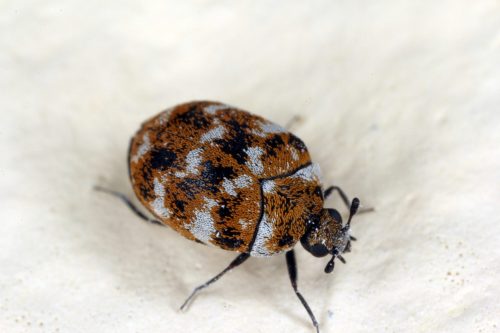
Carpet beetles are commonly confused with bed bugs.
That’s no surprise as both are tiny and harbor in furniture, blankets, carpets, and other household items.
Appearance
Color
The easiest way to tell carpet beetles from bed bugs is with their color.
Bed bugs take on a light brown or dark red color.
In contrast, carpet beetles are either black, brown, or patterned.
The Common carpet beetle and the Varied carpet beetle have patterns with multicolored scales.
These colors include black, white, brown, red, orange, and yellow.
Black carpet beetles have a uniform color that typically ranges from black to dark brown.
Shape
Similar to bed bugs, carpet beetles take on an oval flat-shaped appearance.
The only exception is the Black carpet beetle, which takes on an elongated body.
Antenna and Legs
Carpet beetles and bed bugs also have different looking antennas and legs.
Bed bugs characterized by their diagonal antenna. Carpet beetles, on the other hand, have two bent antennae.
Bed bugs have six legs with four facing backward and two facing forwards. Carpet beetles have six short legs.
Larva or Babies
Another critical distinction between carpet beetles and bed bugs is their larva or babies.
Bed bugs go through a partial metamorphosis, which means their babies look similar to adults, except they are smaller.
Carpet beetles, on the other hand, produce larva.
Larvae look like small fury worms.
They can grow up to ¼ of an inch, have an oval shape, and have Brussels or hairs on their back.
Diet
They will also eat any animal-related fabrics such as wool, blankets, clothing, and upholstery.
You will typically find tears or missing patches on the fabrics carpet beetles feed on.
Habitat
Bed bugs feed on humans and prefer to live near their host.
As such, they are most often found in mattresses, box springs, headboards, nightstands, pillows, and other furniture in bedrooms.
They are also commonly found in living rooms and home offices.
In contrast, carpet beetles live both indoors and outdoors.
They are common in gardens and yards. You can typically find carpet beetles near flowers, trees, or bushes.
Bites
Bed bugs bite humans to feed on blood.
Their bites look like welts and do not have a red spot at the center, unlike other insect bites such as spiders and fleas.
Carpet beetles don’t bite people.
Unlike bed bugs, carpet beetles do not survive off blood; instead, they eat animal-based products such as wool.
That said, some people may experience allergies from carpet beetles.
These allergic reactions are often perceived as bites from carpet beetles, but they not.
2. Dust Mites
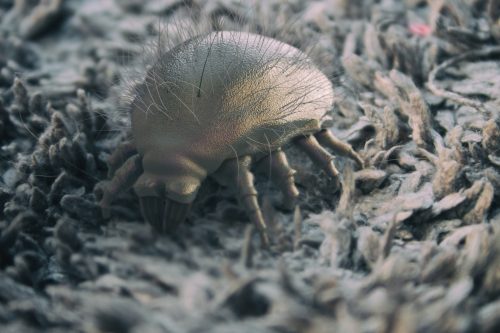
Appearance
Color
Bed bugs range from light brown to dark brown. Dust mites can range from white to light brown.
Size and Shape
Adult Bed bugs are around 3/16 on an inch (4 or 5mm). They can be compared to the size of a short grain of rice.
In contrast, dust mites are microscopic. They are typically around ¼ to ⅓ mm long, which is about a fraction of the size of a bed bug.
Both bed bugs and dust mites have an oval-shaped body.
Antenna and Legs
Bed bugs have six legs with two forward-facing and four backward facing legs.
Dust mites are born with only six legs.
After the first molt, dust mites grow two additional legs.
Diet
Bed bugs drink blood to survive.
Dust mites eat dead skin and hair that fall off humans and other pets.
These pests are also known to eat other such as:
- Cotton fibers
- Paper
- Synthetic materials
- Other mite feces and skin
- Mold
- Fungus
- Pollen
- Feathers
Because Dust mites enjoy an abundance of food in a home, their populations can grow extremely large.
A mattress can have anywhere from 100,000 to 10 million mites inside.
Habitat
Bed bugs primarily live in bedrooms where food is readily available.
The most common areas to find bed bugs in your bedroom is on mattresses, box springs, headboards, nightstands, pillows.
Dust mites live inside homes typically on any fabrics or soft materials around the house.
Some of the most common places that
- Bedsheets
- Mattresses
- Upholstered furniture
- Carpets
- Curtains
- Pillows.
Bites
Dust mites do not bite people, but their presence can cause allergic reactions confused with bed bug bites.
Some symptoms of dust mite allergy include:
- Skin rash
- Sneezing
- Coughing
- Runny or stuffy notes
- Itchy eyes
- Itchy skin
- Itchy throat
Bed bugs bite humans to feed on blood.
When bed bugs bite you, they administer an anesthetic to make it painless. This method allows them to suck your blood without you noticing.
They also release anticoagulants so they can feed on your blood as efficiently as possible.
While bed bug bites are not painful at first, they can eventually become swollen and irritated.
Bed bug bites look like welts and do not have a red spot at the center, unlike other insect bites such as spiders and fleas.
Common locations for bed bites include:
- Arms
- Legs
- Ankles
- Back
- Torso
- Neck
- Feet
3. Ticks
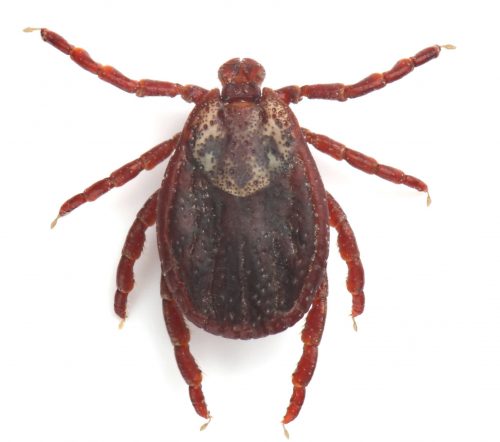
Appearance
Color
Depending on the tick species, their color can vary from light brown to dark red or black. When engorged, ticks become darker and take on a reddish black color.
Shape and Size
Both bed bugs and tick have an oval-shaped body.
Adult bed bugs are 3/16” or around 4 to 5mm. They can be compared to the size of a short grain of rice.
Adult ticks can range in size from 5mm to 15mm. They are much larger when engorged, reaching sizes of 15mm.
Antenna and Legs
Bed bugs have two antennas positioned diagonally from their head. In contrast, ticks do not have antennas.
Larva or Babies
When bed bugs first hatch, they are only about 1.5 mm long. They have white, oval, and flat bodies.
The nymphs also have two antennas and six legs.
As they mature, they gradually turn from white to dark brown.
Baby ticks, on the other hand, emerge as six-legged larvae.
They are typically lighter in color than adults with a color ranging from light brown or red.
Baby ticks are tiny, measuring between 0.5 and 1 mm.
They will molt twice before each adulthood.
Diet
Similar to bed bugs, ticks drink blood to survive.
Adult ticks can survive between one and two years without a host.
Larvae and nymphs can only survive 1-2 weeks without a host before dying.
Habitat
Ticks are quite versatile in their habitat.
They can find them both outdoors and indoors.
Outdoor harborage:
- Fallen branches
- Tall brush
- Grassy areas
- Near wood or wooden areas
- Bird feeders
- Leaf piles and litter
- Along walls and fences
- Near moisture
- Near trash cans
Indoor harborage:
- Carpet
- Bedrooms
- Dog Kennels
- Cat Toys
- Pets
- Mattresses
- Blankets
- Dirty laundry
In contrast, bed bugs flourish in places where humans stay for long periods.
These pests take harbor in mattresses, box springs, headboards, nightstands, pillows, upholstery, and other furniture.
Bites
Both ticks and bed bugs bite to feed on blood.
But, unlike bed bugs, ticks stay attached to their host for several days before releasing their grip.
Bed bugs, on the other hand, leaves its host after feeding.
Tick bites typically leave a small, circular red mark followed by a larger red circle around the smaller red circle.
Bed bug bites look like welts. Their bites also come in a clusters, typically with a zig zag pattern.
4. Fleas
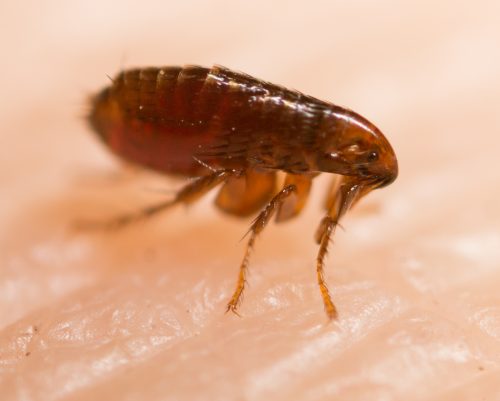
Appearance
Color
Both fleas and bed bugs are light brown to dark brown in color.
Shape and Size
Bed bugs are have oval bodies. Fleas, on the other hand, are more rectangular. They are also more narrow compared to bed bugs.
In terms of size, fleas are typically smaller, but when fully engorged, they are comparable to bed bugs.
Fleas are 2- 4mm while bed bugs are around 4-5mm long.
Antenna and Legs
Bed bugs and fleas have six legs.
Fleas have distinct back legs similar to crickets, which allow them to jump.
They also have distinct legs right below their mouth.
Diet
Like bed bugs, fleas only feed on the blood of mammals.
The difference is the type of blood they prefer.
Bed bugs prefer humans, while fleas prefer pets and other mammals.
That said, both these pests will feed on any warm blooded mammals if there are no other food available.
Habitat
Bed bug’s primary habitat is indoors. You’ll typically find them in bedrooms, living rooms, and office spaces.
In contrast, fleas are more commonly outdoors.
If you return from outdoors with a bite, it is likely a flea, tick, or another insect bite rather than a bed bug bite.
If you have fleas indoors, you’ll likely find them harboring inside carpets, upholstery, and near pet bedding.
Bites
Flea bites and bed bugs bites can look very similar.
Similar to bed bugs, flea bites tend to come in clusters.
One difference between fleas and bed bugs is that fleas typically bite on the legs, ankles, and feet.
Bed bugs tend to bite any exposed skin while sleeping; this includes arms, legs, back, torso, and even neck.
5. Spider Beetles
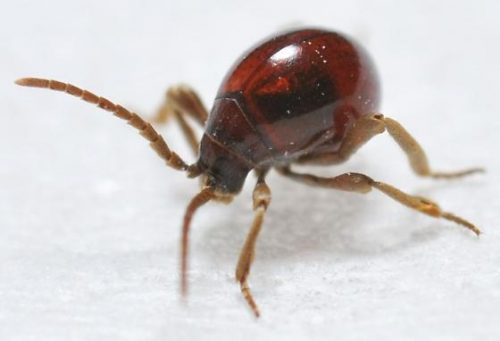
Appearance
Color
Bed bugs range from light brown to dark brown.
Spider beetles can vary in color from light brown to red-brown. Some species can have a pattern on their backs.
Shape and Size
Spider beetles look similar to bed bugs because of their oval shape.
These two insects are also similar in size.
Bed bugs are around 4-5mm long while spider beetles can vary from 1-5mm.
Antenna and Legs
Just like bed bugs, spider beetles have six legs. But their legs are much longer than bed bugs.
Wings
Some species of spider beetles have wings and are capable of flight. Bed bugs, on the other hand, have wing pads but can not fly.
Diet
Spider beetles have a diverse diet. They eat almonds, beans, cereals, cornmeal, dates, mushrooms, figs, nutmeg, bread, and seeds, among other things.
They can also eat hair, feathers, animal skin, dead insects, and textiles.
Bed bugs, on the other hand, rely solely on blood to survive.
Habitat
Bed bugs live next to their host. These pests aggregate in bedrooms, living rooms, and office spaces.
Spider beetles live in wall voids, attics, kitchen, and inside grains or flour.
Bites
Unlike bed bugs, spider beetles do not bite.
They also do not cause any allergies or any diseases.
Bed bugs, on the other hand, bite humans to feed on their blood.
While bed bugs are not known to carry any diseases, their bites can cause discomfort and irritation. The presence of bed bugs can also cause allergic reaction to some.
6. Swallow Bugs
Appearance
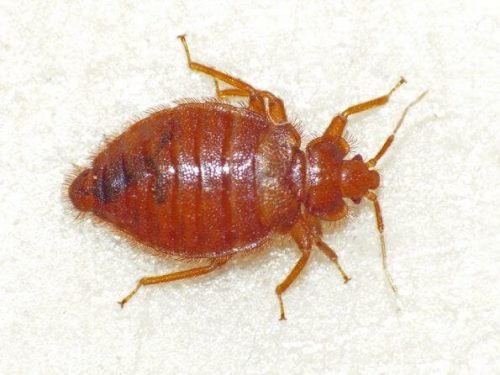
Color
Swallow bugs are a similar color to bed bugs they take on a light brown to reddish-brown.
There is some exception that some swallow bugs can take on a grey tint whereas bed bugs are always light to dark brown.
Shape
Both bed bugs and tick have an oval-shaped, flattened bodies.
Adult bed bugs are 3/16” or around 4 to 5mm.
Swallow bugs grow up to 3/16 of an inch in length.
Antenna and Legs
Both swallow bugs and bed bugs have segmented antennas.
They are different, however, in that bed bugs antennas get thinner towards the tip.
Swallow bugs’ antennas, on the other hand, are uniform is size.
Hair
Swallow begs typically have small hairs around their head and sometimes on their bodies.
Bed bugs do not have any hair.
Diet
Both bed bugs and swallow bugs are blood-sucking insects.
But they prefer to get their blood meals from different hosts.
Swallow bugs prefer to get their source of food from Cliff swallows. Bed bugs, on the other hand, prefer to get their blood meal from humans.
While, swallow bugs can feed on other outdoor mammals such as pigs and horses, but they cannot develop or reproduce without the feeding on cliff swallows’ blood.
Habitat
Unlike bed bugs, swallow bugs are not common in cities.
These bugs are typically found inside barns, farm buildings, large warehouses, storage sheds, and other facilities near ranches or farms.
Bites
Bed bugs prefer not to bite humans. But they will do so if their habitat is destroyed and they have no other food source.
8. Bat Bugs
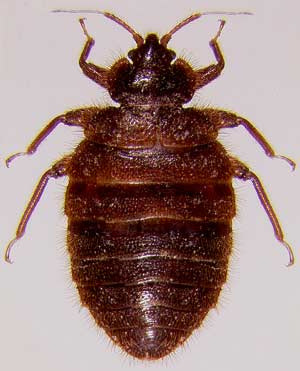
Appearance
Color and Shape
Bat bugs look very similar to bed bugs. They have flat, oval, and reddish-brown bodies.
Antenna and Legs
Similar to bed bugs, bat bugs have six legs and two antennae.
Hair
Bat bugs are unique to bed bugs because they have fringe hairs located just below their head.
Diet
Like bed bugs, they also feed on blood, with their preferred hosts being bats.
These bugs will instead not feed on human blood but will suck on it if food is scarce.
As such, unlike bed bugs, you won’t find bat bugs on mattresses and furniture.
Instead, they generally aggregate in attics.
Habitat
Unlike bed bugs, you won’t find bat bugs on mattresses and furniture.
You’ll find these bugs where bats live such as caves, trees, or outdoor buildings.
If you do find these bugs in your home, they’ll generally be in attics.
Bites
Bat bugs feed primarily on bats, which makes it unlikely for them to bite you.
That said, they will bite you if their primary host is not around.
Bat bug bites look similar to bed bugs.
Like bed bugs, bat bugs don’t transmit diseases. However, they can spread disease found on the feces of bats if they walk through it.
9. Booklice
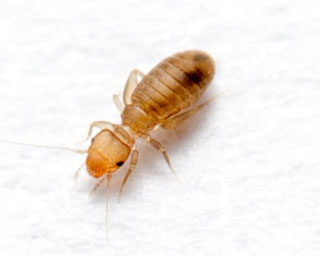
Appearance
Color
Booklice are often confused with baby bed bugs.
Like bed bug nymphs, these insects are white or brown.
Shape and Size
Compared to bed bugs, booklice are small, measuring only 1/32 to ⅛ of an inch.
The oval shape of their body looks very similar to that of a bed bug.
Booklice have a distinct pronotum separating the head and the abdomen.
Antenna
Booklice are different than bed bugs in that they have a much longer antenna.
Diet
Booklice primarily feed on mold and fungus. Bed bugs, on the other hand, rely solely on blood to survive.
Habitat
Booklice dehydrate very quickly. As such, they like to live near moisture or molded areas.
You’ll typically find booklice on window sills, old books, wallpaper, and other water damaged areas.
In contrast, bed bugs generally aggregate in bedrooms, living rooms and office spaces.
These pests like to bed near their host. As such, they are most commonly found on mattresses and headboards.
Bites
Unlike bed bugs, booklice do not bite.
They also do not cause allergic reactions.
However, their skin casings and residue mixed with mold can cause asthma attacks.
10. German Cockroach (Nymph)
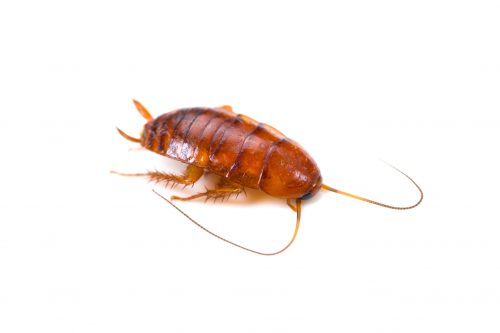
Appearance
Color
Both german roaches and bed bugs are white when they first hatch.
As they grow, both insects will develop a reddish-brown and will look eerily similar to each other.
Shape
Bed bugs have a flat, oval shape, while german roaches are more elongated.
German roaches are one of the smallest type of cockroach. A full-grown adult ranges from ½ to ⅝ of an inch long.
Adult bed bugs are 3/16” or around 4 to 5mm. They are usually the size of poppy seeds throughout their life cycle.
Antenna
German cockroach have a long straight antenna, whereas bed bugs have a shorter, diagonal antenna.
Wings
German cockroaches also have wings, and bed bugs do not.
Diet
Cockroaches are scavengers and will eat anything from crumbs, grease, feces, hair, and dead skin.
In contrast, bed bugs only feed on one thing: blood
Habitat
A german roach’s favorite hiding place is dark, quiet, warm with food and water nearby.
If you have a German cockroach infestation, 99% of the time, they are hiding in your kitchen or bathroom.
Bed bugs are most commonly found in bedrooms or mattresses.
Bites
While German cockroaches can bite people, it’s highly unlikely.
Cockroaches shy away from humans and will avoid us as much as possible.
Reports of cockroaches biting people typically happen in houses with massive infestations.
In this situation, there is insufficient food to support the cockroaches and may result in chewing on fingernails or eyelashes.
Massive infestations are not safe for living.
Most people will never experience such a massive infestation, let alone live in one.
11. Headlice
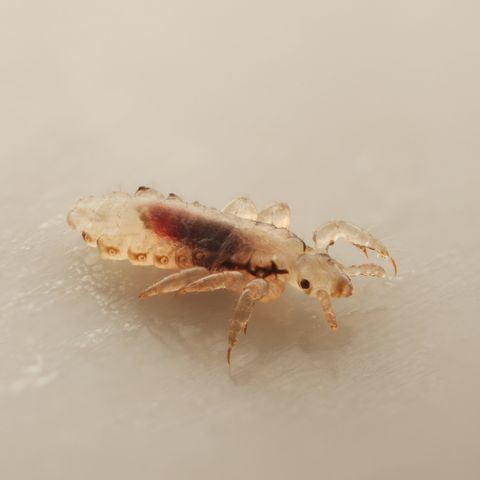
Appearance
Color
Head lice are usually yellow to white in color.
While bed bugs are white right after they hatch, they develop reddish-brown color as they grow.
Shape
Head lice looks very similar to bed bugs, although they are only about half the size when fully grown.
They have a narrower body than bed bugs, although they do have a similar oval abdomen.
Antenna and Legs
Head lice have much shorter antennas than bed bugs.
Both insects have 6 legs.
Diet
Both head lice and bed bugs are blood sucking insects.
Habitat
Head lice are found primarily on the human scalp.
You may see them on your bed, blanket, or pillows when they fall off your head.
Unlike bed bugs, you won’t see lice harboring inside mattresses and box springs.
Bites
Like bed bugs, head lice bite humans to suck on blood.
But, unlike head lice, bed bugs will not typically bite you on your head. They try to avoid areas of your body with hair.
Both insect bites produce similar markings and side effects.
Like bed bugs, head lice bites leave small red bumps and can be extremely uncomfortable and itchy.
12. Kissing Bugs
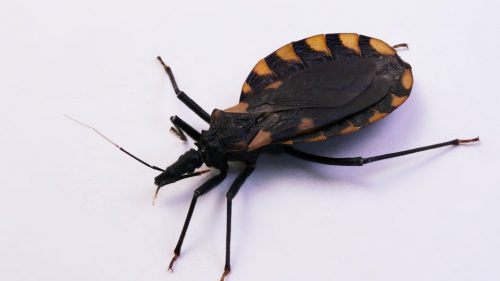
Kissing bugs and bed bugs do not look anything alike. But they are not confused about their appearances but rather because of their bite marks.
Appearance
Color
Kissing bugs are brown or black with a yellow and brown pattern on their abdomen.
Shape and Size
Kissing bugs are significantly larger than bed bugs at ¾” to 1 ¼”.
Antenna and Legs
Both kissing bugs and bed bugs have six legs and two antennas.
Diet
Indoors kissing bugs are typically hidden in cracks, holes, bed frames, floorboards, walls, and inside furniture gaps.
Whereas bed bugs live primarily in bedrooms kissing bugs can fly and crawl to reach their host.
It’s not common for kissing bugs to infest homes but it is possible.
It is more common for them to live outdoors and attack mammals and other rodents for food.
Outdoors they are commonly found in trees, brush piles, or beneath bark.
They also hide were mammals are living such as animals nest and rodent burrows.
If you have pets or other animals outside such as horses or chickens they will hide inside their kennels.
Habitat
Kissing bugs live primarily outdoors.
When they are indoors, they aggregate in bed frames, floorboards, walls, and inside furniture gaps.
Bites
Kissing bugs leave very similar bite marks as bed bugs.
Their bite marks come in clusters and have a similar size as bed bugs.
Kissing bugs are known for transmitting a parasite that causes chiggers’ disease through their bites.
Bed bugs, on the other hand, do not cause or transmit any diseases.
13. Stink Bug
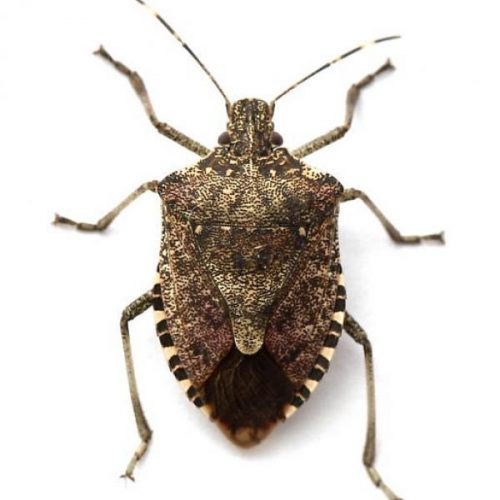
Appearance
Color
Stink bugs have a mottled brownish grey pattern while bed bugs take on a uniform color ranging from light brown to dark red.
Shape and Size
Stink bugs have a similar body shape and color as bed bugs, but they are quite easy to distinguish.
While they have a similar body shape, stink bugs have a triangular body with straight sides.
Bed bugs have an oval body with curved sides.
Stink bugs measure around 5/8th of an inch compared to 3/16th of an inch for bed bugs.
Antenna and Legs
Stink bugs have longer legs and antenna than bed bugs.
Diet
Stinks bugs eat flowers and fruit. They will also feed on crops such as soybeans, cotton, and sorghum.
If these food sources are not available they will resort to eating weeds, grass, and plants.
Indoors stink bugs will feed on plants, fruit, and grains.
Habitat
Outdoors stink bugs are common in gardens, near bushes, trees, and orchards.
They are also common in bushy grass and weeds as well as under objects in grass such as stones or yard ornaments.
Indoors stink bugs live in small crevices, cracks, and wall voids.
They are also common in attics, folds in fabrics, curtains, drapery, and in hollow or dark areas around your home.
Bites
Stink bugs are harmless. They don’t bite or transmit diseases.
In rare cases, they can cause allergic reactions that result in dermatitis.
Though dermatitis should not be confused with bed bug bites because they look distinctly different.
Dermatitis causes a large cluster of rashes
14. Chimney Swift Bug
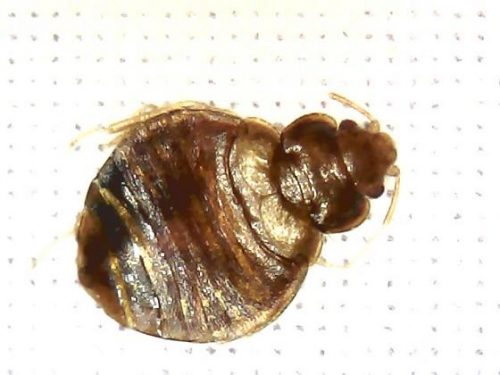
Appearance
Color
The Chimney swift bug is a cousin of the bed bug similar to swallow and bat bugs.
They look very similar to bed bugs in terms of color.
They often take on a light brown or reddish-brown color.
They sometimes appear black, but this is usually due to the soot they live with inside chimneys.
Shape and Size
Chimney bugs are oval, just like bed bugs. The one noticeable difference is that chimney bugs are smaller than bed bugs.
Antenna and Legs
Both chimney bugs and bed bugs have segmented antennas.
They are different; however, in that bed bugs, antennas get shorter towards the tip.
Chimney swift antennas, on the other hand, are uniform in size.
Hair
Chimney bugs typically have small hairs around their head and bodies.
Bed bugs do not have any hair.
Diet
Both bed bugs and chimney swift bugs are blood-sucking insects.
But they prefer to get their blood meals from different hosts.
Chimney swift bugs prefer to get their source of food from chimney swifts, as the name suggests.
These birds build their nest in chimneys, and other vertical surfaces such as air vents, wells, hollow trees, and caves.
Habitat
These bugs are found in the nest of the chimney swift bird.
These birds forage over urban, suburban, rivers, lakes, forests, and fields.
Chimney swift birds are common across the East, Northeast, and Mid West U.S.
There are also some cases of chimney swifts in southern California during the summers.
Bites
Chimney swift bugs prefer not to bite humans.
But they will do so if their habitat is destroyed and they have no other food source.
15. Poultry Bug or Mexican Chicken Bug
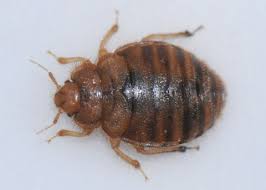
Appearance
Color
The Poultry bug is a cousin of the bed bug similar to swallow and bat bugs.
They look very similar to bed bugs in terms of color.
They often take on a light brown or reddish-brown color.
Shape and Size
Poultry bugs are oval, just like bed bugs. They are also comparable in size.
Poultry bugs are almost identical in terms of shape and size.
Antenna and Legs
Both chimney bugs and bed bugs have segmented antennas.
They are different; however, in that bed bugs, antennas get shorter towards the tip.
Swallow bugs’ antennas, on the other hand, are uniform in size.
Hair
Poultry bugs have small hairs around their head and bodies.
Bed bugs do not have any hair.
Diet
Both bed bugs and poultry bugs are blood-sucking insects.
But they prefer to get their blood meals from different hosts.
Poultry bugs prefer to get their source of food from chickens or other domesticated fowl.
Domesticated fowl are commonly found on farms or ranches.
Habitat
Poultry bugs are common on farms or ranches.
These bed bugs will live near any domesticated fowl.
Bites
Poultry bugs prefer to feed on domesticated fowl.
Given a chance, they will feed on humans, although it’s unlikely.
FAQ
What Attracts Bed Bugs?
The three primary things that bed bugs are attracted to:
- Heat
- CO2
- Histamine
Bed bugs are attracted to these three things because they signal the presence of a host.
Humans produce both heat and CO2.
We release body heat of at least 95 degrees Fahrenheit consistently.
And when we produce CO2 every time, we exhale.
When bed bugs sense CO2 and temperature, they know their next blood meal is close.
Histamine is a chemical that bed bugs use to attract each other to a host.
Bed bugs do this by leaving this chemical on the surface of the skin after biting you.
This chemical signals to other bed bugs that there is food, and it’s safe to eat.
This behavior can help explain why people with bed bugs often end up with clusters of bites.
After a bed bug finds an area to bite you, it alerts other bed bugs in your home to come to enjoy the buffet.
What causes bed bugs?
Bed bugs move from room to room through holes, cracks, and crevices.
They also enter your home by hitchhiking a ride on backpacks, luggage, clothes.
If you’ve traveled somewhere with bed bugs or have a neighbor who has bed bugs, you likely got your bed bugs there.
It’s also possible to get bed bugs if you recently purchase used furniture or other used items such as clothes.
What are the signs of bed bugs?
Some of the most common signs of bed bug infestation are:
- Live bed bugs – Bed bugs are about the size of a grain of rice, oval, flat, and light brown to reddish-brown.
- Bed Bug Eggs – Bed bugs are smaller than a grain of rice, white and are oval.
- Dried blood – Small specs of fresh blood will look like dark red dots around your couch.
- Skin casings – Bed bugs shed their skin to grow. The presence of these skin cases is a good sign of bed bug infestation.
- Bed Bug Feces – bed bug feces appears as small black spots or black/brown streaks.
Where Do Bed Bugs Hide?
Bed bugs aggregate in places near their host, such as mattresses and headboards.
They take harborage in dark places with little airflows such as seams, edges, folds in fabric, and crevices.
They are notorious for hiding on mattresses, box springs, bed boards, nightstands, and anything else near your bed in bedrooms.
Some common places bed bugs aggregate are:
- Mattress
- Bed Frame
- Boxspring
- Clothes
- Nightstand
- Dresser
- Head Board
- Couch
- Electronics
- Carpet
- Luggage
- Blinds
- Curtains
- Cracks, crevices, fabric seams, and folds
